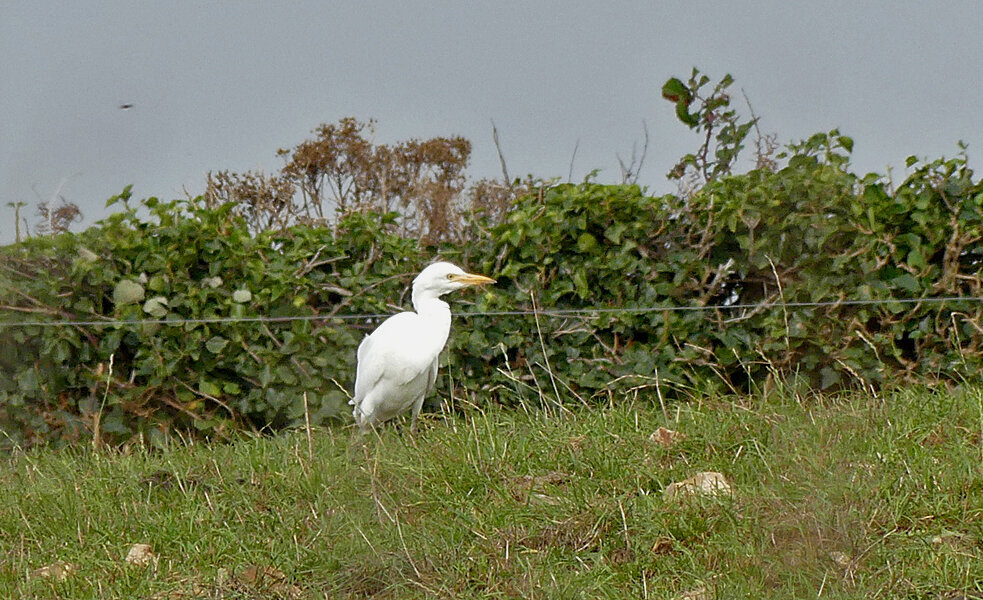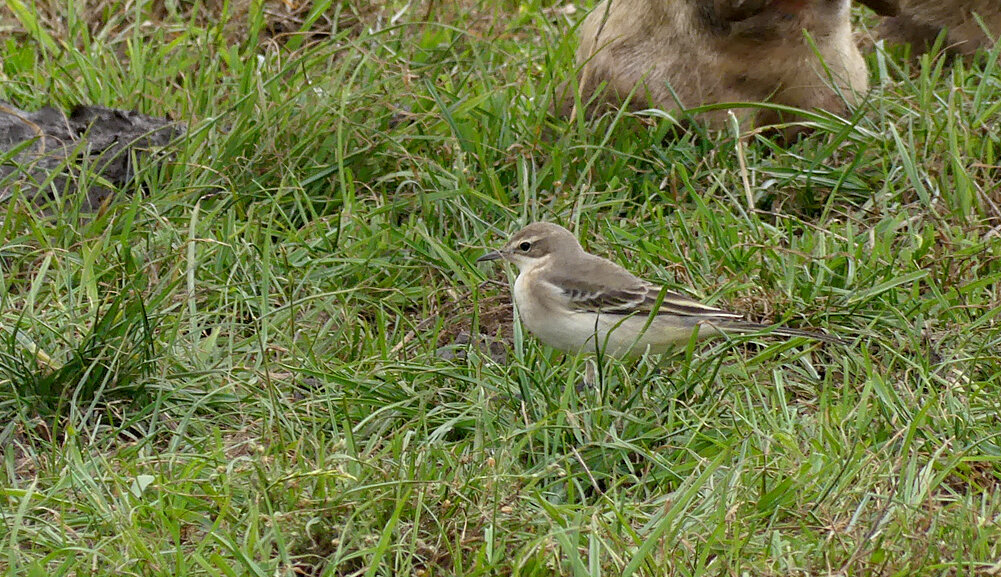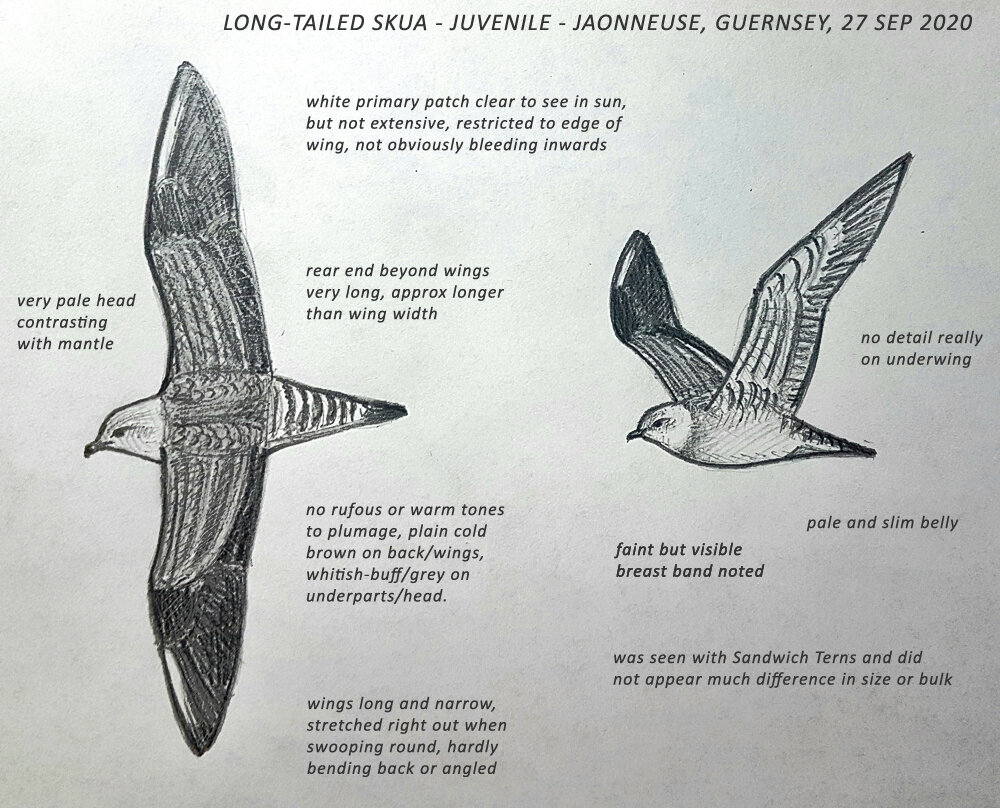September 2020 part ii
/Dotterel - Mont Herault, 20 Sep 20
During the last two weeks of September I saw a pleasing variety of species and there were some terrific days of birding. There wasn’t anything super-rare but there was a new species for Guernsey for me.
On 15th I popped back to Pleinmont after work in case the Pallid Harrier was still around but it had gone already. That day however I did see two decent local birds with a Common Gull on Vazon beach and an early Siskin go over the garden at home. On 17th I had a good patch record when two Teal flew past Pulias along the shoreline - I’ve only a handful of records for the patch. The next day before work the tide was very high and there were large flocks of gulls feeding on the critters collecting along the shoreline. At Vazon there were 11 Med Gulls and a Common Gull, probably more.
Tower field, Pleinmont, 20 Sep 20
The next weekend arrived and on 20th I was up at Pleinmont at first light in decent, sunny conditions, albeit a little breezy on top. There wasn’t a lot of birds around the top of the headland but the first (probably) migrant Firecrests were showing well in the camping field, but apart from single Whinchat and Wheatear, it was quiet for grounded birds.
Firecrest - Pleinmont, 20 Sep 20
So I pushed on towards Mont Herault where there seemed to be more activity in the fields and just east of the scramble track I came across a terrific flock of Yellow Wagtails which were flying round and round me, diving in and out of the grass. There were probably in excess of 30 birds. In the large field a group of 5 Golden Plovers were warily striding around, concerned about the activity next door where they were just about to start clay-pigeon shooting (as soon as the first shots fired out 20 mins later, they were gone).
Golden Plovers - Mont Herault, 20 Sep 20
I knew that there was a Dotterel somewhere in this vicinity and I wasn’t sure exactly where, but I spotted a distant photographer crouching in a grassy field by the cliff edge so I presumed that was where it was. By the time I had walked there I couldn’t see the bird until a tiny head poked out over the slope towards the cliff. I thought that the best tactic would be to sit myself on the ground in the middle of the field and wait for the bird to head back inland. This it did, and pretty soon I had really close views as it tip-toed through the grass. Unlike the Goldies, this bird didn’t seem interested in the gunshots from the next field and just looked puzzled by them.
Dotterel - Mont Herault, 20 Sep 20
Dotterel - Mont Herault, 20 Sep 20
I pushed on along the clifftop further east and could see lots of birds in a cow field just over the next rise. When I got there I could see that this was another flock of Yellow Wagtails. It was difficult to tell how many were in and around the field as it was not all viewable, but it was a minimum of 30, but maybe even double that number. There were also plenty of Meadow Pipits and I could hear a faint lark calling somewhere. I eventually found it distantly in the grass and, despite not having my scope on me, I worked out that it was just a Skylark, my first of the autumn.
Yellow Wagtails - Mont Herault, 20 Sep 20
All of a sudden a Cattle Egret appeared in front of me and stalked around the cows’ legs. It took off every now and then but kept reappearing. Even though they are quite regular now, Cattle Egrets still have a legacy ‘mega’ tag to them and it is always a thrill to spot one. There had been a few sightings in the north and centre of the island at the start of the month but I’d like to think that this had arrived new in from the south and plonked itself in the first cow field it saw.
Cattle Egret - Mont Herault, 20 Sep 20
Cattle Egret - Mont Herault, 20 Sep 20
I’d noticed that one of the distant Yellow Wagtails was looking really grey-coloured and I thought it was possibly a Citrine. So with a little bit of clambering and scrabbling I managed to fight my way through to the other edge of the field for a better look. Here, many of the Yellow Wags were showing really close to the fence for some nice pics. The grey bird was also showing well and I was a little disappointed to see that it didn’t have the head pattern for a Citrine and was just an unusually grey Yellow. I suppose there is a possibility of an Eastern Yellow Wag but it is a little early in the autumn to be considering one of those.
Yellow Wagtail - Mont Herault, 20 Sep 20
Yellow Wagtail - Mont Herault, 20 Sep 20
Yellow Wagtail - Mont Herault, 20 Sep 20
Yellow Wagtail - Mont Herault, 20 Sep 20 - I think that the contrast in the coverts means this is probably a first-winter bird and the brightness of the yellow means it is a male (although I am happy to be corrected)
Whilst taking photos of the wagtails I heard an unfamiliar wader call and looked up to see that the Dotterel had finally got spooked and was heading east along the cliffs. However it turned round and went back the way it came, and I recorded the call on my new device. I headed back through the Mont Herault fields and stopped to look at the original flock of Yellow Wagtails again when a Hobby darted past in front of me, heading east. Then once again the Dotterel appeared and did another fly-past, and I got another, better recording.
Dotterel - Mont Herault, 20 Sep 20
Grey Heron flight call - Pleinmont, 20 Sep 20
Driving home, I stopped to look at L’Eree beach and had a nice selection of waders and gulls, including 10 Bar-tailed Godwits, 5 Golden Plovers (maybe the Pleinmont birds), 4 Med Gulls and a Common Gull. So, nothing very rare found but a super September day in the west.
During the next work week, I didn’t have any real chance to do any quality birding but I did have a migrant Snipe over Ft Hommet on 22nd. There seemed to have been a bit of arrival of Robins and they were much more visible on the headlands, for example this bird feeding in the top car park at Pulias which looked tired enough to have just arrived. These birds often seem to be greyer and paler orange than local birds. But it may just be my imagination - wishfully imagining that they have flown from exotic locations to get here, when it could be the case that they were actually born three bushes away!
Robin - Pulias, 23 Sep 20
The next weekend the winds switched to the north and so Saturday morning, 26th September, I was up on the rocks at Jaonneuse for some seawatching with the guys. And it was a very good morning, with 52 Sooty Shearwaters being a massive count, the most I have seen in a day for over a decade, and some passing pretty close inside the reef. Saw a single Common Scoter and the first few Kittiwakes of the autumn. There were not very many skuas, with 9 Bonxies and 2 Arctics, but we did see a single Pomarine. I had my camera out at the time and managed a (not very close) video. I also managed to get my scope on it and it was relatively good views.
Pomarine Skua - video stills - Jaonneuse, 26 Sep 20
I had a spare hour or two in the afternoon and so I popped out and checked a couple of south coast spots that would be sheltered from the northerly winds. Prevote always looks perfect for hiding a rarity and when I saw a woodpecker dive into a small bush at the bottom of the valley, I immediately thought “sapsucker!” or “middle-spot!!”. Of course, it was a Great Spotted Woodpecker which flew back up the valley into the larger trees. This was an unusual location for this species which is rarely seen away from the centre and east of the island and this tiny coastal valley in the south-west is not ideal - perhaps it was a migrant after all. There were a few Firecrests and Chiffchaffs in the bushes and I was lucky to spot a roosting Barn Owl in a nearby copse which very politely gave me a few minutes to take some nice pictures.
Prevote valley - 26 Sep 20
Red Admiral - Prevote, 26 Sep 20
Barn Owl - Prevote, 26 Sep 20
The winds continued northerly the next day and I was able to give the seawatching a second shot from Jaonneuse. It wasn’t quite a good for shearwaters, although there were more Manx than yesterday. It was much better for skuas however and a total of 49 Bonxies was one of my best days ever for those big boys. Just 3 Arctics wasn’t very many but we saw two excellent Pom Skuas inside the reef. The first was at 0952, a cracker of an adult - with spoons! - and the second one at 1014 was a darker juvenile which showed some helpful ID pointers, like the different rump tone compared to the mantle. This made four Poms in the autumn so far which I think is a record for me.
I was more than satisfied with these, but then at 1030 another skua appeared, taking interest in a couple of Sandwich Terns. This immediately flagged up as a possible Long-tailed Skua since it was not dissimilar in size and had an almost glowing pale head, which looked white in the bright sun. We watched it pass not too far out and even though it was difficult to get fine detail we were very satisfied on the identification (see diagram below for features noted). This was very exciting - a four-skua day! (in fact a four-skua hour). Only my second sighting for Guernsey, the first being in September 2013, which I notice passed at a similar time, 1030. It is still only the 15th record for Guernsey, despite regular seawatching over the last 20 years. You can’t leave early if you want to see decent skuas it seems.
And then just as September was finishing I got a nice easy Guernsey lifer - a Red-necked Phalarope. Monday 28th there was a grapevine message about lunchtime for this bird at Vale Pond. But I was at work of course and I estimated a 50/50 chance that it would still be there on my way home. But it hadn’t flown off, or been eaten by a heron, and I saw it from the hide late in the afternoon. As can be seen from the photo, it wasn’t very close in, but was phalaroping around in the middle of the lake. For some reason this species has been incredibly rare in Guernsey, this being only the 3rd sighting on the island, so a good one to get.
Red-Necked Phalarope - Vale Pond, 28 Sep 20
The final sighting, well hearing, were some Crossbills at Le Guet on 29th. I didn’t see them so I wasn’t sure how many, but there were at least 2 or 3 birds calling. I may have doubted myself, assuming I had misheard, but I had the sound recorder on and was able to double check when I got home.
The only other interesting bird was a colour-ringed Ringed Plover that I had at Vazon on 17th September. The info came back quickly and it had been ringed at the nest in the spring, on an island in the German Baltic. It is not the first migrant Ringed Plover from the same scheme that we have seen on Guernsey.
Colour-ringed Ringed Plover - Vazon, 17 Sep 20
Moth trap-wise there was just one weekend night that was suitable for trapping but nothing hugely significant was caught. Three migrants were a Pearly Underwing, a Vestal and a European Corn-borer.
European Corn-borer - garden, 19 Sep 20

























